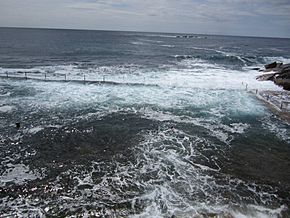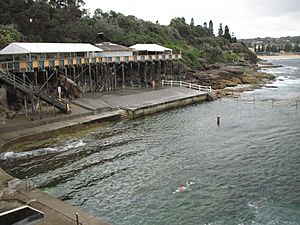Wylie's Baths facts for kids
Quick facts for kids Wylie's Baths |
|
|---|---|

Wylie's Baths, pictured in 2006, looking out to the Tasman Sea
|
|
| 33°55′32″S 151°15′34″E / 33.92566°S 151.25941°E | |
| Address | 4B Neptune Street, Coogee Beach, Sydney, New South Wales, Australia |
| Postcode | 2034 |
| Opened | 1907 |
| Operated by |
|
| Owned by | Randwick City Council |
| Type | Tidal pool |
| Former name(s) | Sunset Pool |
| Status | New South Wales State Heritage Register-listed |
| Length | 50 yards (46 m) |
| Width | 30 metres (98 ft) |
| Depth | 0.5 to 1.6 metres (1 ft 8 in to 5 ft 3 in) |
| Builder | Henry Alexander Wylie |
| Size | |
| Olympic-size pool | |
| Designations | |
|---|---|
| Official name | Wylie's Baths; Wylies Baths; Sunset Pool (1959-1978) |
| Type | State heritage (complex / group) |
| Criteria | a., b., c., d., e., f., g. |
| Designated | 14 November 2003 |
| Reference no. | 01677 |
| Type | Swimming pool - tidal |
| Category | Recreation and entertainment |
| Builders | Henry Alexander Wylie |
Wylie's Baths is a special swimming pool located near Coogee Beach in Sydney, Australia. It's called a "tidal pool" because ocean water flows in and out with the tides. This historic spot is famous for a few reasons. It hosted the very first Australian Swimming Championships. It was also one of the first places in Australia where both boys and girls, men and women, could swim together.
The baths were built in 1907 by Henry Wylie. His daughter, Mina Wylie, became one of Australia's first female Olympic swimmers. She won a silver medal at the 1912 Olympics! From 1959 to 1978, the baths were known as Sunstrip Pool. Today, Randwick City Council owns Wylie's Baths. A special committee, including local swimming clubs, helps manage it.
Contents
Discovering Wylie's Baths History
Early Aboriginal Connections
Aboriginal people have lived in the Sydney area for at least 20,000 years. The local Aboriginal group in the Coogee area was the Cadigal people. It's believed that the spot where Wylie's Baths now stands might have been a special place for Aboriginal women. Some traditions suggest it was linked to birthing, but more research is needed to confirm this. Today, a large Aboriginal community lives in the Randwick area.
How Coogee and Randwick Grew
The area around Coogee and Randwick started to develop in the 1800s. Simeon Pearce, who came from a town called Randwick in England, helped make the area popular. He and his brother bought and sold land. Simeon also pushed for a road from Sydney to Coogee, which was built in 1853.
At first, Randwick was a bit isolated. Getting there was tough because of swamps and sandhills. Wealthy people built big houses, but many working-class families lived in simpler homes. They often worked in market gardens or piggeries. In 1859, Randwick became one of the first areas in New South Wales to form its own local government.
The Randwick Racecourse, established in 1863, brought more life to the area. Trams soon connected Randwick to Sydney, making it a busy and lively place. Today, it's a mix of homes, businesses, and students from the nearby University of New South Wales.
Coogee's Popularity as a Seaside Spot
When the tram line reached Coogee Bay in 1883, Coogee quickly became a popular holiday spot. People loved its beach and fun activities, much like Manly and Bondi. There was an aquarium, a ballroom, and even an indoor swimming pool. Other fun things included swings, donkey rides, and a toboggan rink.
Around this time, swimming became a competitive sport, not just something for health. The first British amateur swimming group started in 1869. In Sydney, many ocean and harbour pools were built in the late 1800s and early 1900s. These included the Dawn Fraser Pool (1882) and Bondi Beach Pool (around 1892). Many were built to Olympic size for races.
Near Wylie's Baths, you can find other historic pools. The McIver Women's Baths, built in 1886, are just north. They have been managed by women's swimming clubs since 1922. At the northern end of Coogee Beach is Giles Baths, built in 1902 for men only.
Building Wylie's Baths (1900s-1959)
In the early 1900s, Henry Alexander Wylie, a champion swimmer and builder, got permission to build a pool. He opened Wylie's Baths on December 12, 1907. He first built a fence and later added a high timber boardwalk and two changing rooms in 1912. He also built a concrete diving tower. For a while, there was even a slippery dip! Night swimming and picnics became popular when Wylie added lights around the pool.
People would pay a small fee at a caretaker's cottage to enter. They could get swimming costumes and use lockers. Paths led down to timber stairs and separate changing rooms for men and women.
Henry Wylie's daughter, Mina Wylie, grew up nearby. She and Fanny Durack were Australia's first two female Olympic swimmers. At the 1912 Stockholm Olympics, Fanny won gold and Mina won silver in the 100-meter freestyle. Mina won an amazing 115 NSW and Australian swimming titles between 1906 and 1934! She also helped start the Randwick Coogee Ladies Amateur Swimming Club.
Another famous swimmer linked to Wylie's Baths was Des Renford. He was a long-distance ocean swimmer who crossed the English Channel 19 times. He swam at Wylie's regularly and helped manage the baths.
Sunstrip Pool Era (1959-1974)
In 1959, Desmond Selby took over the lease and renamed the baths "Sunstrip Pool." He updated the facilities, making the boardwalk wider and the changing rooms smaller to create more space for sunbathing. He even used old tram parts to build the new structures and added hot showers. There was also a kiosk and a store on the boardwalk.
Closing and Re-opening (1974-1978)
In May 1974, big storms badly damaged the baths, and they had to close. More damage happened in 1977. But in 1978, the baths reopened under the Randwick Municipal Council. They went back to their original name, Wylie's Baths. A special committee, with members from local swimming clubs, was formed to help manage them.
Restoring the Baths in 1995
In 1994, the Randwick City Council decided to repair the baths because people really wanted them fixed. The restoration cost about $750,000 and was finished in 1995. The architects, Allen Jack+Cottier, won an award for their sensitive work. They restored the boardwalk and built new facilities, making sure the new parts still felt like the original baths.
In 1996, the Wylie's Baths Trust was created to keep managing the baths. It includes representatives from swimming clubs, local residents, and the Randwick City Council.
Wylie's Baths in Photos
In recent years, Wylie's Baths has become a very popular spot for photographers. Its amazing location, clinging to the cliffs, and its old-fashioned wooden structures make for beautiful pictures.
What Wylie's Baths Looks Like
Wylie's Baths sits on the rocks at the southern end of Coogee Beach. You can enter from Neptune Street.
The pool itself is made of rock and concrete. It's about 50 meters long and 30 meters wide. It's an Olympic-size pool (50 yards long) and its depth changes from about 0.5 meters to 1.6 meters. The ocean tides naturally fill and clean the pool twice a day.
A tall wooden boardwalk, supported by timber posts, wraps around the cliff face on two sides of the pool. You can easily see it from Coogee Beach. Three sets of wooden stairs lead down from the boardwalk to the pool and the rocks. There are changing rooms for men and women, a kiosk, and a store. A steel fence runs along the northern and eastern sides of the pool for safety.
Current Condition and Changes
After a big restoration in 1995, Wylie's Baths is in great shape. Over the years, the baths have been repaired and changed many times. This was necessary because the ocean environment is very harsh. These changes have helped keep the original look and feel of the buildings. The 1995 restoration was praised for keeping the spirit of the old baths while making them modern.
- 1907: Wylie's Baths first opened.
- 1912: The high timber boardwalk and changing rooms were built.
- 1959: Changing rooms were replaced, the boardwalk widened, and the famous checkerboard walls added. A kiosk and store were also built.
- 1974: The baths closed due to storm damage.
- 1977: More storm damage occurred.
- 1991: Stainless steel railings replaced older timber and chain railings.
- 1995: Major restoration work was completed, and the baths reopened.
Why Wylie's Baths is a Special Place
Wylie's Baths is important to the history of New South Wales. It's one of the oldest and most complete ocean swimming pools in the state. It might also be special because of its possible connection to Aboriginal women's traditions.
Built in 1907, Wylie's Baths shows how sports and fun places developed in Sydney long ago. It has been used for many swimming competitions, training, lessons, and just for people to swim and relax. Generations of Sydneysiders have loved Wylie's Baths.
The baths are strongly connected to the history of competitive swimming in Australia. It's linked to famous swimmers like Henry Alexander Wylie, his daughter Mina Wylie, Fanny Durack, and Des Renford. Because Mina Wylie and Fanny Durack competed in the 1912 Olympics, Wylie's Baths is especially important for Australian women's swimming history.
Wylie's Baths is a well-known Sydney landmark. You can see it clearly from Coogee Beach, and its dramatic ocean setting is beautiful. The elevated timber boardwalk is unique and a great example of clever design for building on a steep cliff. The recent restoration in 1995 even won an award for how well it preserved the original feel of the baths.
The baths have a special meaning for the Coogee community. People have loved visiting them since 1907, creating many happy memories. Local swimming clubs have a long history with the baths and helped get them reopened after storm damage in the 1970s. The community continues to be involved in managing the baths today.
Wylie's Baths is also important because it's a great example of an ocean swimming pool built around Sydney's beaches in the early 1900s. Like other pools from that time, it uses rocks and concrete and relies on the tides to keep the water clean. Its unique timber boardwalk is rare and stands out among Sydney's many pools.
See also



